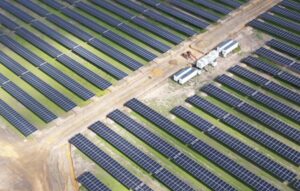Melbourne-based research group the Grattan Institute has thrown another renewables policy idea into the mix, suggesting that the best chance for the Australian government to meet its targets to de-carbonise the country’s electricity grid is to take a leaf out of the policies of the South African and Australian Capital Territory governments and initiate a series of reverse auctions.
In a report entitled “Building the bridge: a practical plan for a low-cost, low-emissions energy future”, Grattan says such auctions would provide the least-cost subsidy, and ensure that emerging low-emission technologies are actually deployed, rather than just talked about, which it argues has been the case so far with the renewable energy target and various grant-bases schemes.
The head of the Grattan Institute’s energy program, Tony Wood, argues that even with a carbon price, the government needed to take a further step to drive down the cost of low-emissions technologies. “Right now, investors are reluctant to back low-emissions technologies because they are expensive and high risk,” Wood said. And they are racked by policy uncertainty.
Essentially, Wood adopts the argument put forward by the International Energy Agency and others that deployment is the best way to bring down costs, because most of these costs lie in “balance of system” (building, connecting, maintaining and financing it) rather than just the price of the technology itself.
The Grattan Institute proposes a series of six-monthly auctions over 10 years with, for example, 300MW of capacity to be sold at each one, split between various technologies such as wind, solar PV, concentrated solar power (CSP, or solar thermal), and others – including carbon capture and storage (CCS) and “dispatchable” technologies. The proposed mechanism is designed to provide a hedge against the carbon price risk and the electricity price risk, with the capacity in each stream being sold to the lowest credible bidder.
Grattan intends to submit its report to the Climate Change Authority, which is being charged by the Federal government to “review” the Renewable Energy Target, although the scope and intent of that review is yet to be clarified.
Reverse auctions have proved a popular and effective mechanism throughout the world, as RenewEconomy highlighted in this piece on South Africa shows Australia how to do green energy, and in our series on the ACT solar auctions, ACT solar auction could be a game-changer. Such auctions have also been used in California, India, China, Brazil and other states in north America and South America. They are seen as a cheaper and more responsive mechanism than fixed feed-in tariffs and do not deliver windfall gains.
Such auctions have also been promoted by others within the industry in Australia, although the federal government has resisted because of its similarity to a feed-in tariff, to which it has been implacably opposed. Federal policy makers have, however, been taking a keen interest in the ACT proposal which is likely to provide the first instance of solar PV “price discovery” in the country, and to get capacity built well before the various federal government grant schemes.
Where the Grattan Institute and others will diverge is in the scale of the ambition, and Grattan’s suggestions that such a scheme replace the renewable energy target – or at least the trading of green energy certificates – rather than augment it. Others agree auctions can create a cost effective use of funds and could be an attractive means of bringing in new technologies, but they argue that such a mechanism should be used to expand Australia’s ambition and be additional to the scope of the Renewable Energy Target.
Wood suggests a series of auctions over 10 years that might amount of 6000MW of capacity, and that would include carbon capture and storage, and might amount to around 5 per cent of capacity – “not enough to distort the market in any material sense.” That represents considerably less deployment than envisaged under the Renewable Energy Target – and may be fiercely opposed by the wind industry – and comes as Origin Energy (a former employer of Wood) is pushing for that target to be reduced in light of falling demand.
Wood argues, however, that some technologies may fall in price so that they do not need any further subsidy. “The object is not to meet a nominal target, the object is to bring costs down,” he told RenewEconomy. Indeed, the Grattan proposal of a maximum 300MW capacity across all technologies would appear to be a limiting factor on some larger projects, although it does recommend a specific exemption for CCS, which it says needs fewer but larger rounds, and with the support of government debt and/or equity.
As a comparison on scale, the South African auction is targeting auctions of 3,725MW over the next five years as a way of kick starting its push into clean energy. It has a renewable energy target of 30,000MW of renewable energy capacity by 2030. Coal currently accounts for around 85 per cent of its electricity production. Its first two rounds of auctions have already caused significant decreases in the prices of contracts bid, particularly within wind and solar PV (bids fell 40 per cent in price from the first round). Strict timelines and bonds are imposed so that any bid that is unrealistic forgoes its capacity. More auctions will be held for smaller-scale installations (less than 5MW)
The ACT system seeks to add 40MW of solar in the first two rounds to be completed by early next year. It seeks up to 220MW over time, including other technologies. It pays a contract for difference between the wholesale price and the bid prices, but expects that by 2020 the wholesale price would have risen to the point where the difference (and the cost to consumers) is negligible. Its proponents have argued that it is adaptable to the national stage with little change, but should be additional to the RET. Indeed, it is not yet clear how the ACT scheme will treat renewable energy certificates, and if they will be surrendered.
In California, the auction is just one of the mechanisms used as part of that state’s ambitious target to source 33 per cent of its energy from renewable sources by 2020. In India, the auctions are used to help meet its ambitious target of 20GW of solar by 2022. It has a separate green energy certificate scheme.
The Grattan Institute says that the auction system would fit in well with the carbon price, but the big question might be how it fits in with the Coalition’s Direct Action Policy. It bears some similarities to the Coalition’s proposal to “auction” emission reduction projects, although the Coalition proposes to fund these projects via a government fund, rather than added to electricity costs as proposed by Grattan. The Coalition also calls for “banding” of some technologies as part of the RET.
Other countries are also wrestling with the best means for deploying clean energy. The UK – which has had a system of renewable energy certificates, as well as “multipliers” for certain technologies such as wave and offshore wind, and specific tariffs for solar – is now considering contracts for difference to ensure it has some new nuclear energy. Instead of a public auction, however, this is likely to be set by negotiation between the government and the few remaining parties still interested in nuclear in the UK, mostly the French government-owned EDF. Analysts suggest the minimum price will be around $150/MWh – around three times the current wholesale price of energy in the UK – which should put paid to the notion that nuclear is cheap. Analysts expect the UK government will have to accept the construction risk as well as the financing risk on those projects.








